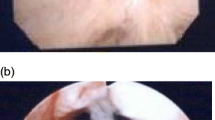Abstract
Purpose
To evaluate the effectiveness of balloon nephrostomy (BN) for treating urinary tract fistulas.
Materials and methods
In a single-center retrospective analysis, 56 patients were treated using BN between 2003 and 2014. All causes of urinary tract fistula were included. We assessed the effectiveness of drainage, complications, and the types of reconstruction surgery used. Success was defined as fistula closure without surgery.
Results
The cohort consisted of 25 males (54%) and 31 females (55%) with a median age of 63 years who underwent BN for a urinary fistula secondary to surgery, i.e., urologic (40%; n = 22), gynecologic (34%; n = 19), or digestive (20%; n = 11). Of these patients, 48 (86%) had a history of cancer (49% had a tumor progression). Median drainage time was 90 days (10–583), with an average of three successive readjustments needed per patient. We obtained a 21% success rate (n = 12), morbidity was 6.5% (urinary sepsis, renal abscess, ureteral stricture), and 7% of patients developed ureteral stricture after balloon removal. There was no recurrence of any fistula within a median follow-up time of 15.2 months.
Conclusion
This minimally invasive procedure can be used for selected urinary tract fistulas with few complications. It can also be used safely in populations that have several comorbidities.


Similar content being viewed by others
References
Lynch TH, Martinez-Pineiro L, Plas E, Serafetinides E, Turkeri L, Santucci RA, et al. EAU guidelines on urological trauma. Eur Urol. 2005;47(1):1–15.
Flores-Carreras O, Cabrera JR, Galeano PA, Torres FE. Fistulas of the urinary tract in gynecologic and obstetric surgery. Int Urogynecol J Pelvic Floor Dysfunct. 2001;12(3):203–14.
Hennessey DB, Bolton E, Thomas AZ, Lynch TH (2013) Vesicocutaneous fistula following adjuvant radiotherapy for prostate cancer. BMJ Case reports. https://doi.org/10.1136/bcr-2013-008986
Bryk DJ, Zhao LC (2015) Guideline of guidelines: A review of urologic trauma guidelines. BJU Int.
Aristide Kabore F, Kambou T, Ouattara A, Zango B, Yameogo C, Kirakoya B, et al. Epidemiology, etiology and psychosocial impact of urogenital fistulas in a cohort of 170 consecutive patients managed in three treatment centers in Burkina Faso from 2010 to 2012. Prog Urol. 2014;24(8):526–32.
Obarisiagbon EO, Olagbuji BN, Onuora VC, Oguike TC, Ande AB. Iatrogenic urological injuries complicating obstetric and gynaecological procedures. Singap Med J. 2011;52(10):738–41.
Koukouras D, Petsas T, Liatsikos E, Kallidonis P, Sdralis EK, Adonakis G, et al. Percutaneous minimally invasive management of iatrogenic ureteral injuries. J Endourol/Endourol Soc. 2010;24(12):1921–7.
Msezane L, Reynolds WS, Mhapsekar R, Gerber G, Steinberg G. Open surgical repair of ureteral strictures and fistulas following radical cystectomy and urinary diversion. J Urol. 2008;179(4):1428–31.
Avritscher R, Madoff DC, Ramirez PT, Wallace MJ, Ahrar K, Morello FA Jr, et al. Fistulas of the lower urinary tract: percutaneous approaches for the management of a difficult clinical entity. Radiographics. 2004;24(Suppl 1):S217–36.
Gunther RW, Klose KJ, Alken P, Bohl J. Transrenal ureteral occlusion using a detachable balloon. Urol Radiol. 1984;6(3-4):210–4.
Horenblas S, Kroger R, van Boven E, Meinhardt W, Newling DW. Use of balloon catheters for ureteral occlusion in urinary leakage. Eur Urol. 2000;38(5):613–7.
Zairi A, Nohra J, Khedis M, Thoulouzan M, Otal P, Joffre F, et al. Results of balloon nephrostomy in the treatment of lower urinary tract fistula. Prog Urol: J Assoc Fr Urol Soc Fr Urol. 2008;18(6):372–8.
Dindo D, Demartines N, Clavien PA. Classification of surgical complications: a new proposal with evaluation in a cohort of 6336 patients and results of a survey. Ann Surg. 2004;240(2):205–13.
De Ridder D. An update on surgery for vesicovaginal and urethrovaginal fistulae. Curr Opin Urol. 2011;21(4):297–300.
Burks FN, Santucci RA. Management of iatrogenic ureteral injury. Ther Adv Urol. 2014;6(3):115–24.
Al-Otaibi KM. Ureterovaginal fistulas: the role of endoscopy and a percutaneous approach. Urol Ann. 2012;4(2):102–5.
Franke M, Winand S, Chang DH, Wille S, Maintz D, Bangard C. Urinary tract fistulas: Transrenal reversible ureteral occlusion with detachable Semicompliant balloons. Urology. 2015;86(2):388–93.
Oakley SH, Brown HW, Greer JA, Richardson ML, Adelowo A, Yurteri-Kaplan L, et al. Management of vesicovaginal fistulae: a multicenter analysis from the Fellows’ pelvic research network. Female Pelvic Med Reconstr Surg. 2014;20(1):7–13.
Papanicolaou N, Pfister RC, Yoder IC. Percutaneous occlusion of ureteral leaks and fistulae using nondetachable balloons. Urol Radiol. 1985;7(1):28–31.
Li C, Liu Z, Yang F. Predictors of catheter-related bladder discomfort after urological surgery. J Huazhong Univ Sci Technol Med Sci. 2014;34(4):559–62.
Waaldijk K. The immediate surgical management of fresh obstetric fistulas with catheter and/or early closure. Int J Gynaecol Obstet. 1994;45(1):11–6.
Linder BJ, Umbreit EC, Larson D, Dozois EJ, Thapa P, Elliott DS. Effect of prior radiotherapy and ablative therapy on surgical outcomes for the treatment of rectourethral fistulas. J Urol. 2013;190(4):1287–91.
Degirmenci T, Gunlusoy B, Kozacioglu Z, Arslan M, Ceylan Y, Ors B, et al. Utilization of a modified Clavien classification system in reporting complications after ultrasound-guided percutaneous nephrostomy tube placement: comparison to standard Society of Interventional Radiology practice guidelines. Urology. 2013;81(6):1161–7.
Paluku JL, Carter TE. Obstetric vesico-vaginal fistulae seen in the northern Democratic Republic of Congo: a descriptive study. Afr Health Sci. 2015;15(4):1104–11.
Author information
Authors and Affiliations
Corresponding author
Ethics declarations
Conflicts of interest
None.
Ethical standards
The patients’ characteristics and treatment strategies were collected by screening medical records after approval from our Institutional Review Board.
Rights and permissions
About this article
Cite this article
Gas, J., Nouhaud, FX., Roumiguié, M. et al. Management of urinary-tract fistulas using reversible balloon nephrostomy: a single-center retrospective analysis of 56 patients. Int Urogynecol J 30, 287–292 (2019). https://doi.org/10.1007/s00192-018-3628-0
Received:
Accepted:
Published:
Issue Date:
DOI: https://doi.org/10.1007/s00192-018-3628-0




